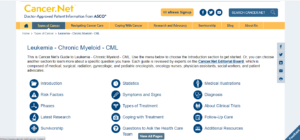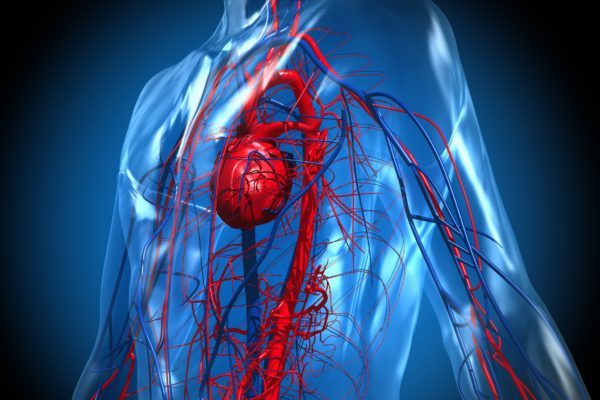Clinical picture
There are many types of chronic leukaemia. Some produce too many cells and some cause too few cells to be produced. Chronic leukaemia involves mature blood cells. These blood cells replicate or accumulate slowly and can function normally for a period of time. Some forms of chronic leukaemia initially produce no early symptoms and can go unnoticed or undiagnosed for years. People with chronic lymphocytic leukaemia often die not from the leukaemia itself, but from complications such as infections.
Common forms of chronic leukemia are chronic lymphocytic leukaemia and chronic myeloid leukaemia.
Chronic lymphocytic leukaemia
Chronic lymphocytic leukaemia (CLL) is a type of cancer in which the bone marrow makes too many lymphocytes, a type of white blood cell. Because this form of leukaemia involves an overproduction of mature, reasonably well functioning lymphocytes, people with this disease can survive for many years, even without treatment. Early on there are typically no symptoms. Later, non-painful lymph node swelling, fatigue, fever, or weight loss for no clear reason may occur. Enlargement of the spleen and anaemia may also occur. It typically worsens gradually and treatment will be necessary.
Chronic lymphocytic leukaemia is most common in adults 50 years of age and older. The disease occurs two to three times more often in men than in women. This gender preference is more pronounced in CLL than other forms of leukaemia.
Chronic myeloid leukaemia
Chronic myeloid leukaemia (CML) is a form of leukaemia that affects 20% of all leukaemia patients. In CML too many white blood cells (granulocytes) are produced. CML is divided into 3 different phases: chronic, accelerated, or blast.
- Chronic phase: The blood and bone marrow contain less than 10% blasts. Blasts are immature white blood cells. This phase can last for several years, but can progress to the accelerated or blast phases. About 90% of people have chronic phase CML when diagnosed. Some people with chronic phase CML experience symptoms and some do not.
- Accelerated phase: Most patients with this phase of CML have 10% to 19% blasts in both the blood and bone marrow or more than 20% basophils in the peripheral blood. A basophil is a special type of white blood cell. These cells sometimes have new cytogenetic changes in addition to the Philadelphia chromosome, because of additional DNA damage and mutations in the CML cells.
- Blast phase: Also called blast crisis. In the blast phase, there are 20% or more blasts in the blood or bone marrow. The CML cells often have additional genetic changes as well. The blast cells can look like the immature cells seen in patients with other types of leukaemia, specifically0cute lymphoblastic leukaemia for about 25% of patients or acute myeloid leukaemia for most patients. Patients in blast phase often have a fever, an enlarged spleen, weight loss, and generally feel unwell.
Without effective treatment, CML in chronic phase will eventually move into accelerated phase at first followed by the blast phase in about 3 to 4 years after diagnosis. Patients often experience blast phase sooner when they have more blasts or an increased number of basophils, chromosome changes in addition to the Philadelphia chromosome (a chromosome commonly associated with leukaemia), high numbers of white blood cells, or a very enlarged spleen.
Types of chronic leukaemia
Some forms of chronic leukaemia are:
- Atypical chronic myeloid leukaemia: Philadelphia chromosome negative chronic myeloid leukaemia. This is similar to chronic myeloid leukaemia, in which cells of myeloid lineage rapidly proliferate, however, the Philadelphia chromosome is not detected during chromosome analysis of the patient.
- Chronic eosinophilic leukaemia (CEL) and hyper eosinophil syndrome (HES): In eosinophilic leukaemia, the bone marrow produces too many specific white blood cells (eosinophilic granulocytes). Chronic means that the disease develops slowly and is usually long-lasting.
CEL, like Hyper Eosinophilic Syndrome (HES), falls under the eosinophilic blood disorders. In HES, there is uncontrolled growth of eosinophilic leukocytes in blood, bone marrow, and often in other tissues, leading to organ damage.
- Chronic myelomonocytic leukemia (CMML): A form of chronic myeloid leukemia in which the number of monocytes in the blood and bone marrow is increased. A characteristic of this disease is that it lacks the Philadelphia chromosome.o A form of chronic myeloid leukemia in which the number of monocytes in blood and bone marrow is increased. A characteristic of this disease is that it lacks the Philadelphia chromosome.
- Chronic neutrophilic leukemia (CNL): In neutrophilic leukemia, the bone marrow produces too many specific white blood cells (neutrophil granulocytes). Chronic means that the disease develops slowly and is usually long-lasting.
- Juvenile myelomonocytic leukemia (JMML): Juvenile Myelomonocytic Leukemia is a serious chronic leukemia (blood cancer) that mainly affects children up to 4 years of age.
Symptoms
Although specific symptoms can vary between subtypes of leukaemia, general symptoms include:
- bruising easily
- pale skin
- shortness of breath
- fatigue
- fever
- enlarged spleen and/or liver
- small red spots (Petechiae)
- bone pain
- infections
Diagnosis
Chronic lymphocytic leukemia
The following tests may be used to diagnose CLL:
- Focused medical history of a patient.
- Blood tests: complete blood count (CBC). A person with CLL may have too many white blood cells and low levels of red blood cells and platelets. Also the type of white blood cells will be determined through flow cytometry, also called immunophenotyping, and cytochemistry.
- Genomic and molecular testing for specific genes, proteins, chromosome changes, and other factors unique to the leukemia. Some of the genetic changes that occur in CLL include:
- The deletion of the long arm of chromosome 13 [del(13q)], which is found in about half of patients.
- An extra copy of chromosome 12 (trisomy 12)
- del(11q)
- del(17p)
- NOTCH1 mutations
- SF3B1 mutations
- TP53 abnormalities
- MYD88 mutations
- IGVH
- Imaging tests (x-ray, CT or CAT scan) to detect CLL in parts of the body.
- Bone marrow aspiration and biopsy.
Chronic myeloid leukemia
Not everyone with chronic myeloid leukemia has symptoms. When symptoms are present, they’re often vague and non-specific. The leukemia is often found when their doctor orders blood tests for an unrelated health problem or during a routine check-up.
This list describes options for diagnosing CML. Not all tests listed below will be used for every person. For most types of cancer, a biopsy is the only sure way for the doctor to know if an area of the body has cancer. In a biopsy, the doctor takes a small sample of tissue for testing in a laboratory. If a biopsy is not possible, the doctor may suggest other tests that will help make a diagnosis.
The following tests may be used to diagnose or monitor CML:
- Focused medical history of a patient.
- Blood tests: complete blood count (CBC). People with CML have high levels of white blood cells. In advanced CML there may also be low levels of red blood cells (anemia, and either high or low numbers of platelets.
- Bone marrow aspiration and biopsy.
- Molecular testing for specific genes, proteins, and other factors unique to the leukemia.
- Cytogenetics to analyze a cell’s chromosomes. For most people with CML, the Philadelphia (Ph+) chromosome and the BCR-ABL fusion gene can be found through testing, which confirms the diagnosis.
- Cytogenetic testing for CML is used to monitor how well treatment is working and if it is reducing the number of cells with the Philadelphia chromosome.
- Imaging tests (CT or CAT scan or ultrasound) to find out if the leukemia is affecting other parts of the body.
Treatment
Patients with symptoms and/or large amounts of CLL in the blood, lymph nodes, or spleen often need treatment shortly after diagnosis. For other patients, however, immediate treatment is not needed. For these patients, it is recommended that the disease be monitored carefully without active treatment. This is the standard approach for patients with early-stage disease and no symptoms. Treatment is recommended for patients with worsening blood counts and for those who develop symptoms. The following therapies may be used:
- Chemotherapy.
- Monoclonal antibodies that recognise and attach to specific proteins on the surface of leukaemia cells.
- Kinase enzyme inhibitors. Kinase inhibitors for CLL are fairly new and may only be available for patients with CLL that has returned or worsened or that partipate in clinical trials.





